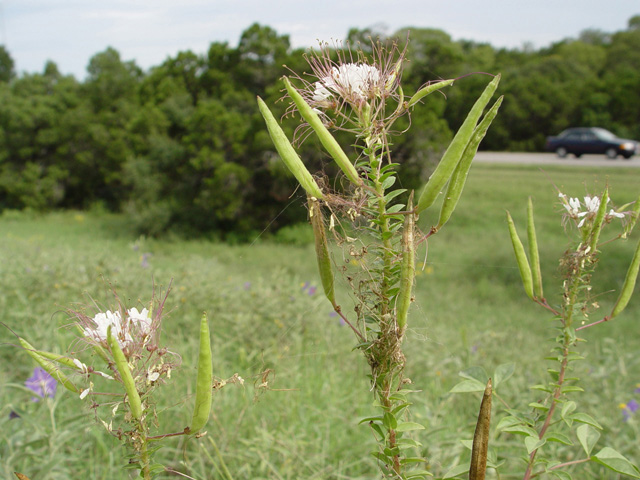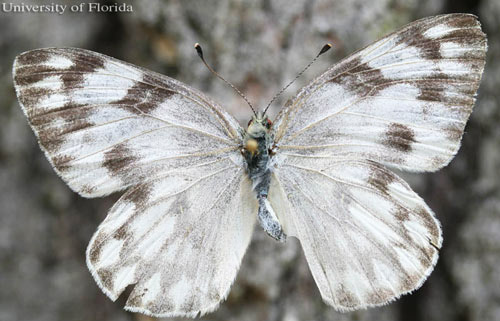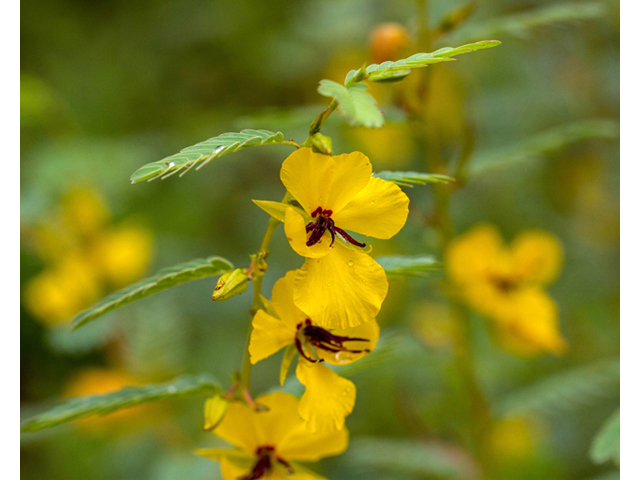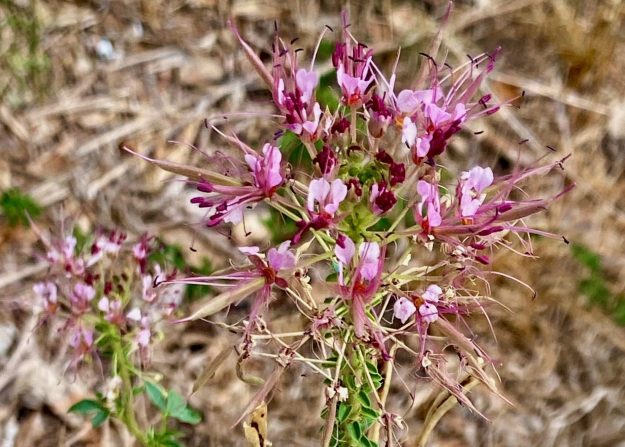The people have spoken: Clammyweed takes the title as 2024 Unofficial Pollinator Plant of the Year with 60% of the vote.
The poll launched January 22 and closed at 7 pm on February 7 with 321 votes cast. The final count: Clammyweed 192, Partridge Pea 129.

Clammyweed — Photo by Melody Lytle via Lady Bird Johnson Wildflower Center
The drought tolerant, purple blooming member of the caper family thrives in extreme heat and made itself known late last year as one of few nectar sources available during 2023’s historically hot summer. San Antonio seed supplier DK Seeds started including Clammyweed, Polanisia dodecandra, in its pollinator seed mix several years ago. It appears to be well adapted to our landscape.
Sometimes called Redwhisker Clammyweed because of the the fluffy, pinkish-purple hairs that extrude from its head, Clammyweed is a warm season annual forb that grows in most soils throughout much of Texas. It can reach 3’ in height. Its showy flowers provide nectar for butterflies in the most extreme days of summer.
According to DK Seeds, one trial near Kingsville, Texas drew more than 50 butterfly species utilizing the species during summer. Clammyweed also works as a host plant to the Cabbage White, Checkered White and Great Southern White butterflies.

The Checkered White is one of several butterflies that lays its eggs on Clammyweed. –Photo by Donald W. Hall, University of Florida.
The plant’s distinctive, strong smell and sticky moistness of the glandular hairs that cover its stems offer the bonus of making it unappealing to deer and livestock. Birds, dove, turkey and quail utilize its seed as a protein source–but don’t eat the “beans.” Even though the plant is a member of the caper family, this version can be toxic to humans.
Local nursery folks applauded this year’s outcome, and pledged to get the mostly absent native plant in stock this spring.
“Hooray for Clammyweed!” said Donald Gerber, owner of Pollinatives Nursery, which will reopen its doors next week following a winter break. “It always had my vote.”
Gerber said that Pollinatives will offer two types of Clammyweed this spring–a wild species and a limited number of the NRCS release of Polanisia dodecandra spp. riograndensis, also known as “Rio Grande” Clammyweed.
Brandon Kirby of Rainbow Gardens, San Antonio’s largest independent nursery with two locations, said his team is working with a group of suppliers to put Clammyweed into limited production this year. “It’s a great reseeding annual that’s tough as nails in the Texas heat,” he said.

Partridge pea –Photo by Holmes, James Garland, via Lady BirdJohnson Wildflower Center
“LOVE this plant,” said Drake White, owner of the Nectar Bar, San Antonio’s first native plant nursery, which also reopens next week. “It’s native, it’s a fabulous nectar source, a butterfly host plant, and prefers to be neglected–what’s not to love about it?”
Fans of Partridge Pea vied admirably for the win and were gracious in defeat. As of this writing, no claims of a “rigged” election have been expressed.
Special thanks to our friends at the Native Plant Society of San Antonio chapter for helping us spread the word and choosing the nominees. And gracias to all for participating in this year’s poll.
NOTE: Started in 2019 by the Texas Butterfly Ranch, the Unofficial Pollinator Plant of the Year campaign aims to raise awareness of the unsung plant heroes of the pollinator garden. Many worthy, native plants are frequently unavailable and ONLY found at seasonal pop-up plant sales. Some are only found in the wild. If you miss these occasional plant sales or spotting these plant gems in the wildscape, you’re out of luck.
Commercial and retail nurseries cite “lack of demand” as the reason these plants are absent from their stores. They also cite some natives’ persnickety growth habits and the fact that it can take two years for some plants to reach a mature enough stage to warrant customer interest.
The goal of our Unofficial Pollinator Plant of the Year is to drive demand for more native plants at gardening centers, local nurseries and big box stores. We encourage you to request these plants when shopping to stock your landscape.
TOP PHOTO: Courtesy Ladybird Johnson Wildflower Center
Related articles:
- Past “Unofficial” Pollinator Plants of the Year
- FINALLY! San Antonio gets its first native plant nursery
- Pollinatives, San Antonio’s second native plant nursery, results from couple’s retirement “deal”
- Mostly native urban pollinator garden outperforms lawn every time
- Flower “bed” works overtime as bachelor pad for solitary bees
- Trinational friendship garden woos pollinators and their fans to Confluence Park
- Doug Tallamy proposes crowdsourcing a homegrown national park: Who’s in?
Like what you’re reading? Don’t miss a single article from the Texas Butterfly Ranch. Sign up for email delivery at the bottom of this page, like us on Facebook, follow us on Twitter, @monikam or on Instagram.
Share this:
- Click to share on Facebook (Opens in new window) Facebook
- Click to share on X (Opens in new window) X
- Click to email a link to a friend (Opens in new window) Email
- Click to share on LinkedIn (Opens in new window) LinkedIn
- Click to share on WhatsApp (Opens in new window) WhatsApp
- Click to share on Nextdoor (Opens in new window) Nextdoor


Partridge pea deserves a bigger photo, and more love.
I love clammyweed – I first noticed it and collected wild seed in an unbuilt commercial lot bordering my neighborhood, because it looks like a wild cleome. Turns out it’s related. This is the one wildflower species that is guaranteed to bloom all summer and fall in central TX, it is basically bombproof. Once established, the plants are prolific seeders and you’ll find yourself thinning them and/or giving some away to neighbors! Honeybees and other bee/wasp species love it. Many summers it’s the only thing that looks alive, with perennial species waiting on rainfall to leaf out and bloom if there has been a drought.
Love my clammy weed. So do the butterflies hummingbird moths and bees and even the hummingbirds are attracted to them
Just a heads up. Clammyweed is not a legume. You correctly stated that Clammyweed is in the Caper Family, while all legumes are in the Fabiaceae Family.
Aaack! Thank you for pointing that out! It’s still an awesome plant, but we will correct the record.
Gracias. — Monika